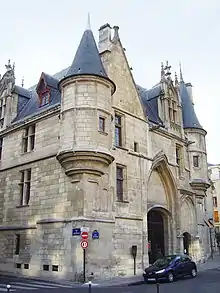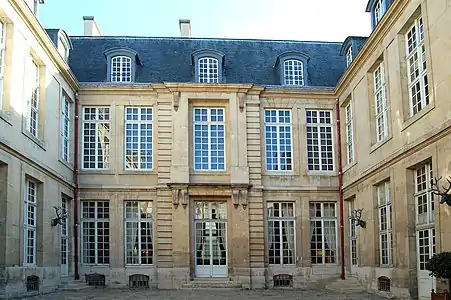The Marais
The Marais (Le Marais French: [lə maʁɛ] ⓘ; "the marsh") is a historic district in Paris, France. It spreads across parts of the 3rd and 4th arrondissements on the Rive Droite, or Right Bank, of the Seine. Having once been an aristocratic district, it is home to many buildings of historic and architectural importance. It lost its status as a fashionable district in the late 18th century, with only minor nobles calling the area home. After the French Revolution, the district fell into disrepair and was abandoned by nobility. After a long period of decay, the district has undergone transformation in recent years and is now once again amongst the more fashionable areas of Paris ,[1] known for its art galleries, upscale restaurants and museums.

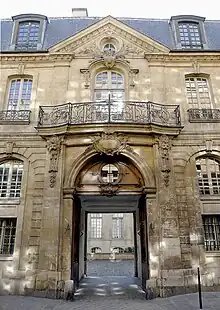
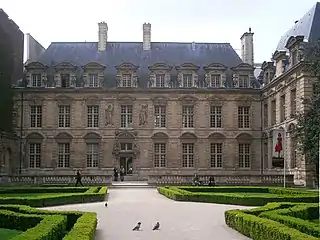
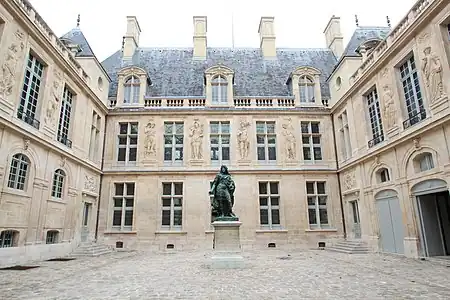
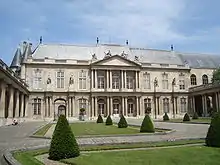
History
Paris aristocratic district
In 1240, the Knights Templar built a fortified church just outside the walls of Paris, in the northern part of the Marais. Later on, The Temple (also known as the Temple Quarter) had many religious institutions built nearby. These include: the convents des Blancs-Manteaux, de Sainte-Croix-de-la-Bretonnerie and des Carmes-Billettes, as well as the church of Sainte-Catherine-du-Val-des-Écoliers.
During the mid-13th century, Charles I of Anjou, King of Naples and Sicily, and brother of King Louis IX of France built his residence near the current n°7 rue de Sévigné.[2] In 1361, King Charles V built a mansion known as the Hôtel Saint-Pol, in which the Royal Court settled during his reign (as well as his son's).
From that time to the 17th century and especially after the Royal Square (Place Royale, current place des Vosges) was designed under King Henri IV of France in 1605, the Marais was the favoured place of residence of the French nobility. Among the many urban mansions—hôtels particuliers, in French—they built there were the Hôtel de Sens, the Hôtel de Sully, the Hôtel de Beauvais, the Hôtel Carnavalet, the Hôtel de Guénégaud and the Hôtel de Soubise.
During the late 18th century, the district was no longer considered the most fashionable district by the nobility, yet it still kept its reputation of being an aristocratic area. By that time, only minor nobles and a few higher ranking nobles, such as the Prince de Soubise, lived there. The Place des Vosges remained a place for nobles to meet. The district fell into disrepair after the French Revolution and was then abandoned by the nobility completely. It was to remain unfashionable until the late 20th century.
Jewish community
After the French Revolution, the district was no longer the aristocratic district it had been during the 17th and 18th centuries. Because of this, the district became a popular and active commercial area, hosting one of Paris' main Jewish communities. At the end of the 19th century and during the first half of the 20th, the district around the rue des Rosiers, referred to as the "Pletzl", welcomed many Eastern European Jews (Ashkenazi) who reinforced the district's clothing specialization. During World War II the Jewish community was targeted by the Nazis who were occupying France. As of today, the rue des Rosiers remains a major center of the Paris Jewish community, which has made a comeback since the 1990s. Public notices announce Jewish events, bookshops specialize in Jewish books, and numerous restaurants and other outlets sell kosher food.
The synagogue on 10 rue Pavée is adjacent to the rue des Rosiers.[3] It was designed in 1913 by Art Nouveau architect Hector Guimard, who designed many Paris Metro stations. The Marais houses the Museum of Jewish Art and History, the largest French museum of Jewish art and history. The museum conveys the extensive history and culture of Jews in Europe and North Africa from the Middle Ages to the 20th century.[4][5]
In 1982, Palestinian extremists murdered 6 people and injured 22 at a Jewish restaurant in the Marais, Chez Jo Goldenberg, an attack which evidenced ties to the Abu Nidal Organization.[6][7][8]
Post-war rehabilitation
By the 1950s, the district had become a working-class area and most of its architectural masterpieces were in a state of neglect. In 1964, General de Gaulle's Culture Minister, Andre Malraux, made the Marais the first secteur sauvegardé (literally translated as safeguarded sector). That was meant to protect and conserve places deemed to be of special cultural significance. In the following decades, the government and the city led an active restoration and Rehabilitation Policy.
The main hôtels particuliers have since been restored and turned into museums: the Hôtel Salé hosts the Picasso Museum, the Hôtel Carnavalet the Paris Historical Museum, the Hôtel Donon the Cognacq-Jay Museum, and the Hôtel de Saint-Aignan hosts the Musée d'Art et d'Histoire du Judaïsme. The site of Beaubourg, the western part of Marais, was chosen for the Centre Georges Pompidou, France's national Museum of Modern Art, which is widely considered one of the world's most important cultural institutions. The building was completed in 1977 with advanced modern architectural features by Renzo Piano and Richard Rogers.
Present day
The Marais is now one of Paris' most frequented localities for art galleries. Following its restoration, the Marais has now become a popular and culture-defining district, home to many upscale restaurants, museums, fashion houses, and galleries.
The Marais is also known for its Chinese community, which first formed during World War I. At that time, France needed workers on the home front to perform the duties previously filled by men who were now soldiers on the front lines. China sent a few thousand of its citizens, on the condition that they would not actually take part in the war. Following the 1918 Allied victory, some of them stayed in Paris, living around the current rue au Maire. Today, most work in jewellery and leather-related products. The Marais' Chinese community has mainly settled in the north of the district, particularly in the vicinity of Place de la République. Next to it, on the Rue du Temple, is the Chinese Church of Paris.
Other features of the neighborhood include the Musée Picasso, the house of Nicolas Flamel, the Musée Cognacq-Jay, and the Musée Carnavalet.
LGBT culture
The Marais became a center of LGBT culture, beginning in the 1980s. Florence Tamagne, author of Paris: 'Resting on its Laurels'?, wrote that the Marais "is less a 'village' where one lives and works than an entrance to a pleasure area" and that this differentiates it from Anglo-American gay villages.[9] Tamagne added that like US gay villages, the Marais has "an emphasis on 'commercialism, gay pride and coming-out of the closet'".[9] Le Dépôt, one of the largest cruising bars in Europe as of 2014 (per Tamagne), is in the Marais area.[9]
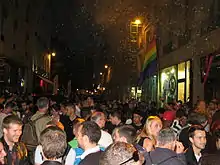 Gay village in the Marais
Gay village in the Marais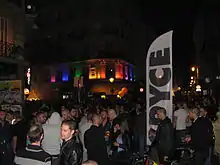
Notable residents
- Maximilien de Béthune, duc de Sully†
- Urbain de Maillé-Brézé†
- Armand de Vignerot du Plessis†
- Princes of Rohan Soubise
- Catherine de Vivonne, marquise de Rambouillet†
- Marie de Rabutin-Chantal, marquise de Sévigné†
- Maximilien Robespierre†
- Victor Hugo†
- John Galliano
- Jacques Frémontier†
- Jack Lang
- Dominique Strauss-Kahn and Anne Sinclair
- Jim Morrison†[10][11]
Places and monuments of note
- National Archives, including the Hôtel de Soubise and Hôtel de Rohan
- Carnavalet Museum
- Church Notre-Dame-des-Blancs-Manteaux
- Church of St-Gervais-et-St-Protais
- Church Saint-Merri
- Church of Saint-Nicolas-des-Champs
- Church of Saint-Paul-Saint-Louis
- Hôtel d'Angoulême Lamoignon (housing the Bibliothèque Historique de la Ville de Paris and the Hôtel-Lamoignon - Mark Ashton Garden.
- Hôtel d'Aumont
- Hôtel de Beauvais
- Hôtel de Sens
- Hôtel de Sully
- Place des Vosges, including the home of Victor Hugo and Café Ma Bourgogne
- Maison européenne de la photographie in the Hôtel de Camtobre (1706)
- Mémorial de la Shoah, including the Memorial of the Unknown Jewish Martyr and the CDJC
- Musée Cognacq-Jay
- Musée d'Art et d'Histoire du Judaïsme (housed in the Hôtel de Saint-Aignan)
- Musée des Arts et Métiers
- Musée Picasso
- Place des Émeutes-de-Stonewall (Stonewall riots square)
- Place Harvey Milk
- Pletzl, the historic Jewish quarter
- Rosiers – Joseph Migneret Garden
- Temple du Marais
Gallery
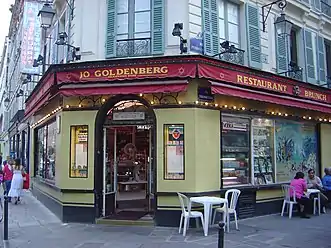 Jo Goldenberg's Jewish delicatessen (now defunct) on the rue des Rosiers; site of the Goldenberg restaurant attack
Jo Goldenberg's Jewish delicatessen (now defunct) on the rue des Rosiers; site of the Goldenberg restaurant attack_01.jpg.webp) Chez Marianne, a Jewish restaurant in Le Marais
Chez Marianne, a Jewish restaurant in Le Marais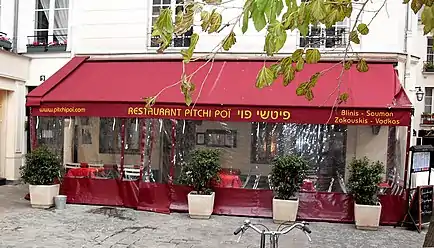 Restaurant Pitchi Poï in the predominantly Jewish Pletzl quarter
Restaurant Pitchi Poï in the predominantly Jewish Pletzl quarter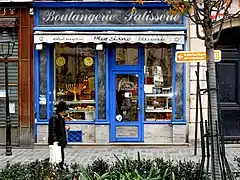 Murciano Jewish bakery in the rue des Rosiers
Murciano Jewish bakery in the rue des Rosiers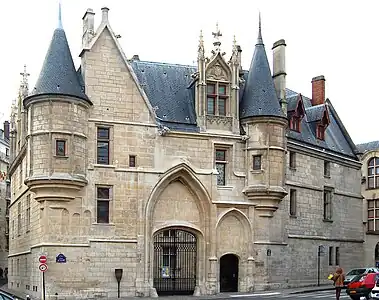 Hôtel de Sens
Hôtel de Sens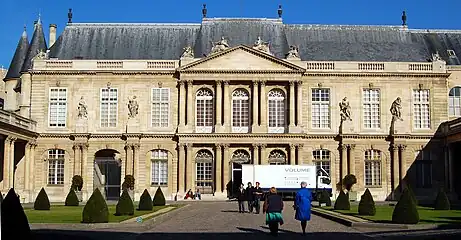 Hôtel Soubise
Hôtel Soubise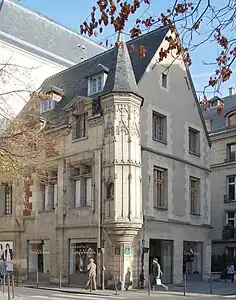 Maison de Jean Herouet
Maison de Jean Herouet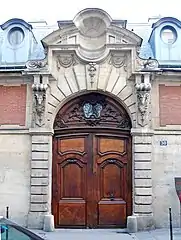 Entrance of l'Hôtel d'Almeras
Entrance of l'Hôtel d'Almeras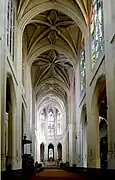 Interior of Saint-Gervais-et-Saint-Protais Church
Interior of Saint-Gervais-et-Saint-Protais Church Saint-Paul Saint-Louis Church
Saint-Paul Saint-Louis Church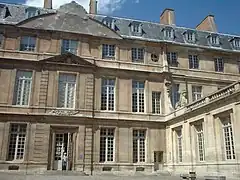 Hôtel Salé (Picasso Museum)
Hôtel Salé (Picasso Museum)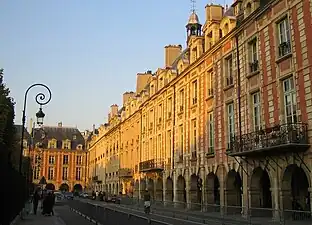 Place des Vosges
Place des Vosges Medieval cellar of the Hôtel de Beauvais
Medieval cellar of the Hôtel de Beauvais.JPG.webp) Medieval houses in rue Miron
Medieval houses in rue Miron Reading room in the Bibliothèque Historique de la Ville de Paris (City of Paris History Library)
Reading room in the Bibliothèque Historique de la Ville de Paris (City of Paris History Library)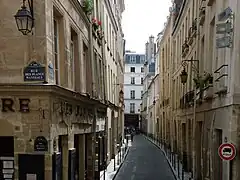 View of rue Aubriot
View of rue Aubriot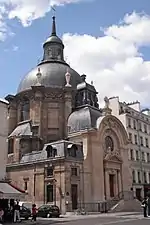 Temple du Marais, a Protestant church
Temple du Marais, a Protestant church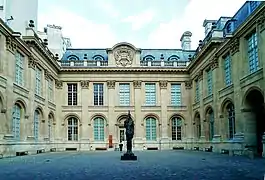 Courtyard of the Hotel de Saint-Aignan, which houses the Musée d'Art et d'Histoire du Judaïsme
Courtyard of the Hotel de Saint-Aignan, which houses the Musée d'Art et d'Histoire du Judaïsme
See also
References
- "Le Marais in Paris". Paris Digest. 2018. Retrieved 10 September 2018.
- This hôtel remained until 1868, and the rue du Roi-de-Sicile is named after it.
- JARRASSE Dominique, Guide du patrimoine juif parisien, éditions Parigramme, 2003, p. 121-125.
- Godet, Jean-Christophe (2011). "Musée d'Art et d'Histoire du Judaïsme," TimeOut Paris (online, 13 September), see , accessed 15 November 2015.
- "Musée d'Art et d'Histoire du Judaïsme".
- Samuel, Henry (17 June 2005). "Suspected mastermind of 1982 Paris Jewish restaurant attack 'bailed in Jordan'". The Telegraph. Retrieved 15 November 2015.
- Massoulié, François (1999). Middle East Conflicts. Interlink Illustrated Histories. Northampton, Massachusetts, USA: Interlink Books. p. 98. ISBN 978-1566562379. Retrieved 15 November 2014.
- Harrison, Michael M. (1994). "France and International Terrorism: Problem and Response". In Charters, David (ed.). The Deadly Sin of Terrorism: Its Effect on Democracy and Civil Liberty in Six Countries. Contributions in Political Science, No. 340 (Johnpoll, B. K., ser. ed.). Westport, Connecticut: ABC-CLIO/Greenwood. p. 108. ISBN 978-0313289644. Retrieved 15 November 2014.
- Tamagne, Florence (2014). "Paris: 'Resting on its Laurels'?" (Chapter 12). In: Evans, Jennifer V. and Matt Cook. Queer Cities, Queer Cultures: Europe since 1945, pp. 240, 250, London, ENG: Bloomsbury Publishing, ISBN 144114840X, 9781441148407, see 240 and , accessed 15 November 2015.
- Anon. (9 July 1971). "Jim Morrison: Lead rock singer dies in Paris". The Toronto Star. United Press International. p. 26.
- Young, Michelle (1 July 2014). "The Apartment in Paris Where Jim Morrison Died at 17 Rue Beautreillis". Untapped Cities. Retrieved 15 November 2015.
Further reading
- Caron, David (2009). My Father and I : The Marais and the Queerness of Community. Ithaca, New York: Cornell University Press. ISBN 978-0-8014-4773-0. OCLC 263065358.
- Sibalis, Michael. "Urban Space and Homosexuality: The Example of the Marais, Paris' 'Gay Ghetto'" (Wilfrid Laurier University). Urban Studies. August 2004 vol. 41 no. 9 p. 1739-1758. DOI 10.1080/0042098042000243138.
External links
- Le Marais
- Le Marais: The Indifferent Ghetto Archived 6 April 2004 at the Wayback Machine Article about the Marais as the gay neighbourhood of Paris
- Gay Paris: English speaking gay walks in Paris
- ParisMarais.com: the official guide, partner of the Paris Tourist Office
- Le Marais photos
- Marais district Photographs
- My Gay Paris The latest news on Paris and the Marais with a gay perspective
